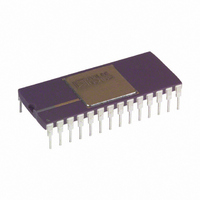AD678KD Analog Devices Inc, AD678KD Datasheet - Page 10

AD678KD
Manufacturer Part Number
AD678KD
Description
A/D Converter (A-D) IC
Manufacturer
Analog Devices Inc
Datasheet
1.AD678JNZ.pdf
(14 pages)
Specifications of AD678KD
No. Of Bits
12 Bit
Mounting Type
Through Hole
Features
BiMOS, High-Impedance/-Bandwidth, 10V, AC/DC
No. Of Channels
1
Interface Type
Parallel
Package / Case
28-CDIP
Rohs Status
RoHS non-compliant
Number Of Bits
12
Sampling Rate (per Second)
200k
Data Interface
Parallel
Number Of Converters
2
Power Dissipation (max)
745mw
Voltage Supply Source
Analog and Digital, Dual ±
Operating Temperature
0°C ~ 70°C
Lead Free Status / RoHS Status
Available stocks
Company
Part Number
Manufacturer
Quantity
Price
Part Number:
AD678KD
Manufacturer:
ADI/亚德诺
Quantity:
20 000
AD678
OUTPUT ENABLE OPERATION
The data bits (DB11–DB0) are three-state outputs enabled by
Chip Select (CS) and Output Enable (OE). CS should be LOW
t
(HBE) are bidirectional. In 12-bit mode they are data output
bits. In 8-bit mode they are inputs which define the format of
the output register.
In unipolar mode (BIPOFF tied to AGND), the output coding
is straight binary. In bipolar mode (BIPOFF tied to REF
output coding is twos complement binary.
When EOC goes HIGH, the conversion is completed and the
output data may be read. Bringing OE LOW t
brought LOW makes the output register contents available on
the data bits. A period of time t
brought HIGH before the next SC instruction may be issued.
Figure 10 illustrates the 8-bit read mode (12/8 = LOW), where
only DB11–DB4 are used as output lines onto an 8-bit bus. The
output is read in two steps, with the high byte read first, followed
by the low byte. High Byte Enable (HBE) controls the output
sequence. The 12-bit result can be right or left justified depend-
ing on the state of R/L.
In 12-bit read mode (12/8 = HIGH), a single READ operation
accesses all 12 output bits on DB11-DB0 for interface to a
16-bit bus. Figure 11 provides the output timing relationships.
Note that t
issued at intervals closer than 5 µs. If SC is asserted sooner than
5 µs, conversion accuracy may deteriorate. For this reason, SC
should not be held LOW in an attempt to operate in a continu-
ously converting mode.
OE
before OE is brought LOW. Bits DB1 (R/L) and DB0
Figure 11. Output Timing, 12-Bit Read Mode
Figure 10. Output Timing, 8-Bit Read Mode
CR
must be observed, in that SC pulses should not be
NOTE
1
IN ASYNCHRONOUS MODE, SC IS INDEPENDENT OF CS
CD
is required after OE is
OE
after CS is
OUT
),
–10–
POWER-UP
The AD678 typically requires 10 µs after power-up to reset
internal logic.
APPLICATION INFORMATION
INPUT CONNECTIONS AND CALIBRATION
The high (10 MΩ) input impedance of the AD678 eases the
task of interfacing to high source impedances or multiplexer
channel-to-channel mismatches of up to 1000 Ω. The 10 V p-p
full-scale input range accepts the majority of signal voltages
without the need for voltage divider networks which could dete-
riorate the accuracy of the ADC.
The AD678 is factory trimmed to minimize linearity, offset and
gain errors. In unipolar mode, the only external component that
is required is a 50 Ω ± 1% resistor. Two resistors are required in
bipolar mode. If offset and gain are not critical (as in some ac
applications), even these components can be eliminated.
In some applications, offset and gain errors need to be trimmed
out completely. The following sections describe the correct pro-
cedure for these various situations.
UNIPOLAR RANGE INPUTS
Offset and gain errors can be trimmed out by using the configu-
ration shown in Figure 12. This circuit allows approximately
± 25 mV of offset trim range (± 10 LSB) and ± 0.5% of gain trim
(± 20 LSB).
The first transition (from 0000 0000 0000 to 0000 0000 0001)
should nominally occur for an input level of +1/2 LSB (1.22 mV
above ground for a 10 V range). To trim unipolar zero to this
nominal value, apply a 1.22 mV signal to AIN and adjust R1
until the first transition is located.
The gain trim is done by adjusting R2. If the nominal value is
required, apply a signal 1 1/2 LSB below full scale (9.9963 V for
a 10 V range) and adjust R2 until the last transition is located
(1111 1111 1110 to 1111 1111 1111).
If offset adjustment is not required, BIPOFF should be con-
nected directly to AGND. If gain adjustment is not required, R2
should be replaced with a fixed 50 Ω ± 1% metal film resistor. If
REF
error will be approximately 1%.
BIPOLAR RANGE INPUTS
The connections for the bipolar mode are shown in Figure 13.
In this mode, data output coding will be in twos complement
binary. This circuit will allow approximately ± 25 mV of offset
trim range (± 10 LSB) and ± 0.5% of gain trim range (20 LSB).
Either or both of the trim pots can be replaced with 50 Ω ± 1%
fixed resistors if the AD678 accuracy limits are sufficient for the
application. If the pins are shorted together, the additional offset
and gain errors will be approximately 1%.
To trim bipolar zero to its nominal value, apply a signal 1/2 LSB
below midrange (–1.22 mV for a ± 5 V range) and adjust R1
until the major carry transition is located (1111 1111 1111 to
0000 0000 0000). To trim the gain, apply a signal 1 1/2 LSB
below full scale (+4.9963 V for a ± 5 V range) and adjust R2 to
give the last positive transition (0111 1111 1110 to 0111 1111
1111). These trims are interactive so several iterations may be
necessary for convergence.
OUT
is connected directly to REF
IN
, the additional gain
REV. C













